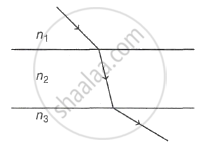Advertisements
Advertisements
प्रश्न
Answer the following question.
Why is photolysis of water accompanied with non-cyclic photophosphorylation?
उत्तर
- Photolysis of water provides new electrons to Photosystem – II.
- The water molecule is lysed into three components:
a. Protons (H+) which are used as part of reactions that make NADPH.
b. The Second component formed is electrons which replaces the electrons lost by PS-II.
c. The third component is oxygen (O2) which is released into the atmosphere. - Photosystem I sends electrons to reduce NADP+.
- Then, Photosystem II sends replacement electrons to Photosystem I.
- Finally, the photolysis of water replaces the electrons lost by Photosystem II.
- Water is the ultimate source of electrons for photosynthesis.
Therefore, the photolysis of water is accompanied by non – cyclic photophosphorylation.
APPEARS IN
संबंधित प्रश्न
A concave mirror of curvature 40 cm, used for shaving purposes produces image of double size as that of the object. Object distance must be ______.
Solve Numerical example.
A monochromatic ray of light strike the water (n = 4/3) surface in a cylindrical vessel at angle of incidence 53°. Depth of water is 36 cm. After striking the water surface, how long will the light take to reach the bottom of the vessel? [Angles of the most popular Pythagorean triangle of sides in the ratio 3:4:5 are nearly 37°, 53°, and 90°]
Light of wavelength 5000 A.U. falls on a plane reflecting surface. The frequency of reflected light is ______
Which of the following is not a property of light?
A ray of light is incident at an angle ion one face of prism of small angle A and emerges normally from the other surface. µ is the refractive index of the material of the prism. The angle of incidence is _____________.
A parallel beam of fast-moving electrons is incident perpendicular on a narrow slit. The distance between slit and screen is large. If the speed of the incident electrons is increased then which one of the following statements is correct?
In the biprism experiment, fringes are obtained using monochromatic light. The distance between the 5th bright band and 9th dark band on the same side of the central bright band, in terms of the fringe width 'X' is ______
The critical angle for light travelling from medium P to medium Q is 'θ'. The speed of light in medium P is 'v'. Then the speed of light in medium Q is ______.
In a compound microscope, let u0 and v0 be the object distance and image distance respectively. The objective of focal length f0 magnifies a tiny object into a real, inverted image. The linear magnification of the objective is ______.
A beam of light passes from medium 1 to medium 2 to medium 3 as shown in the diagram. What may be concluded about the three refractive indices n1, n2 and n3?

